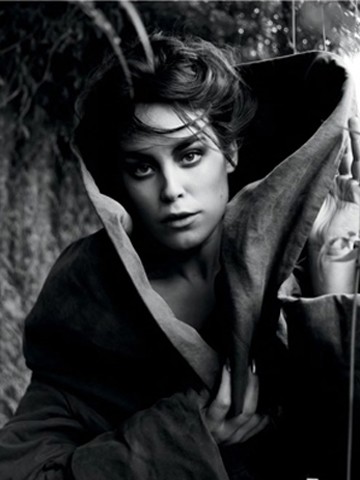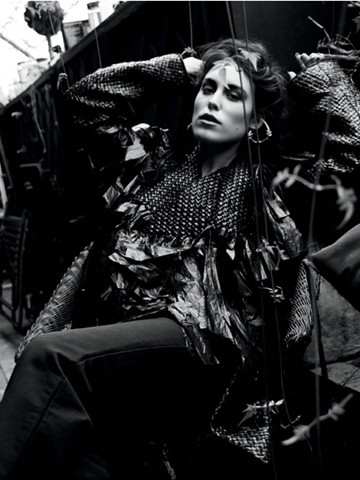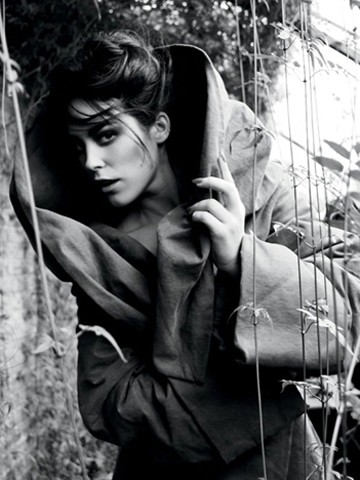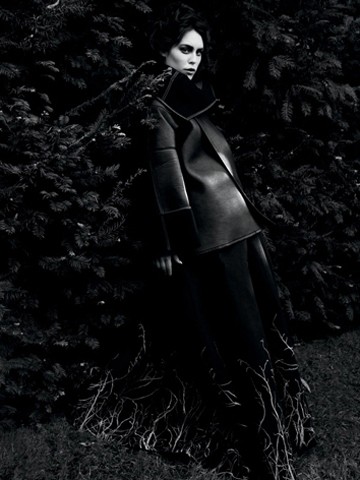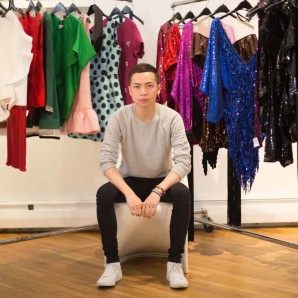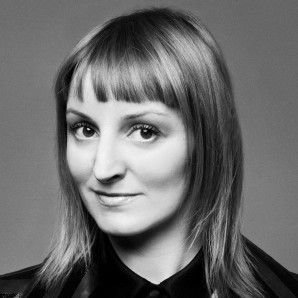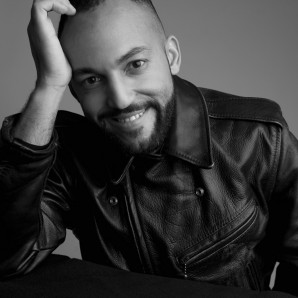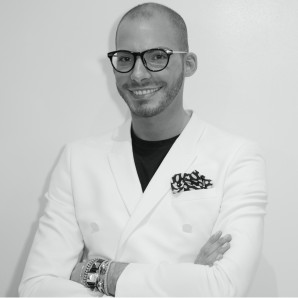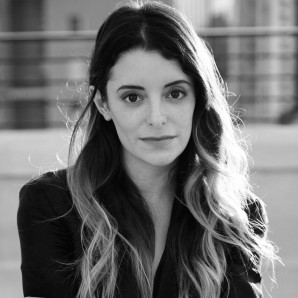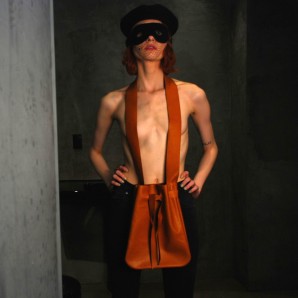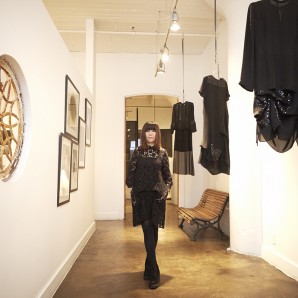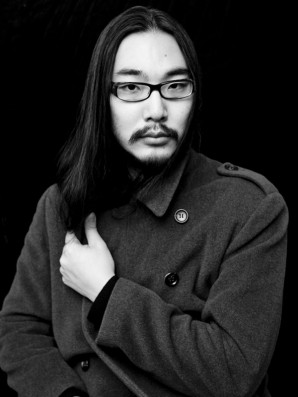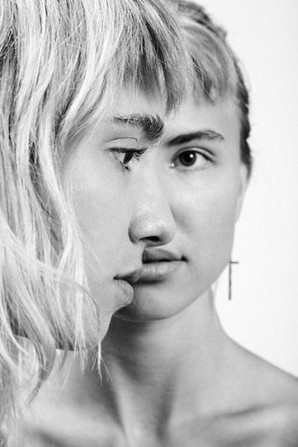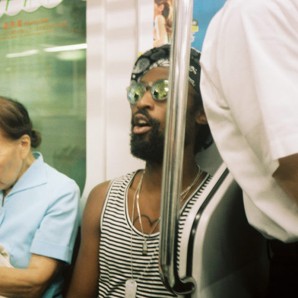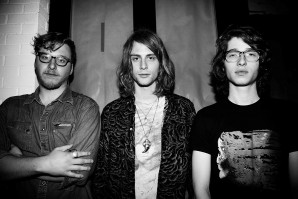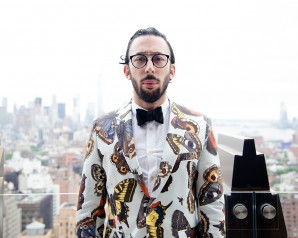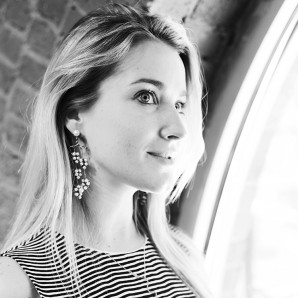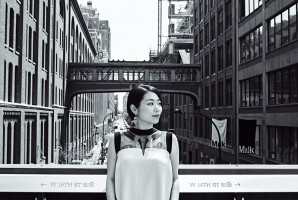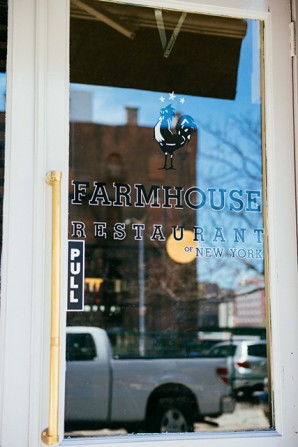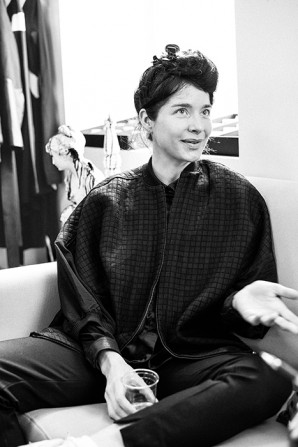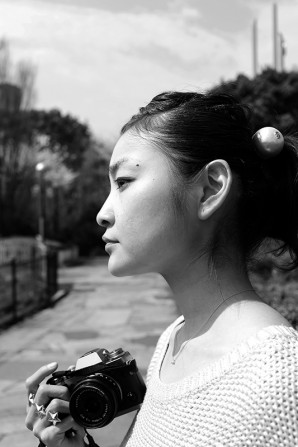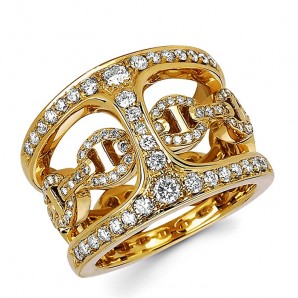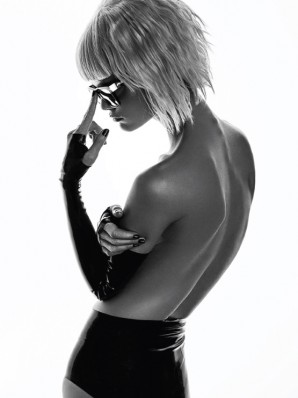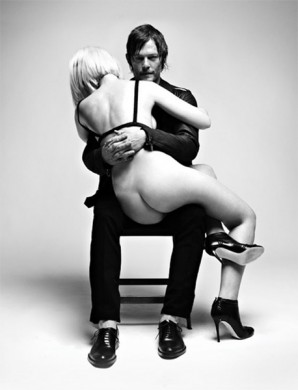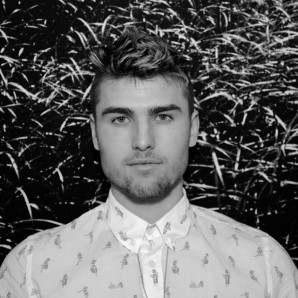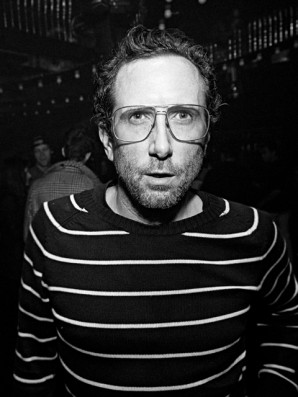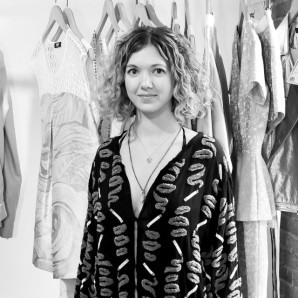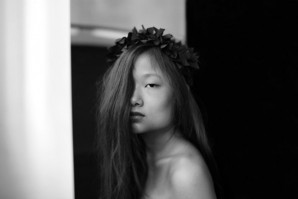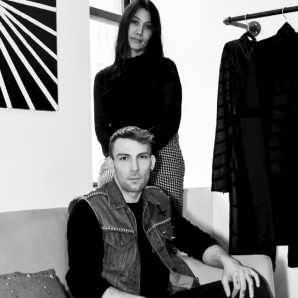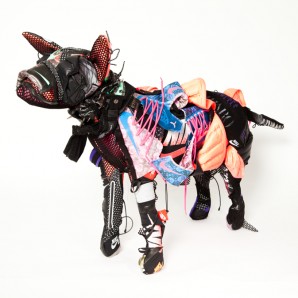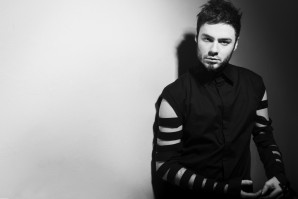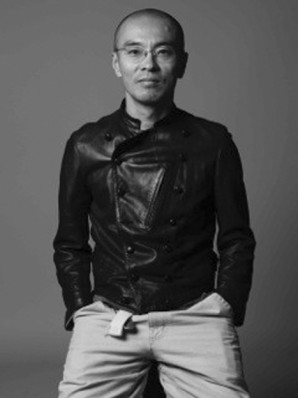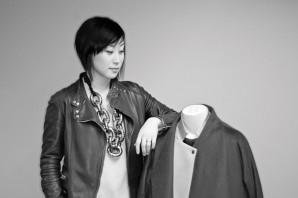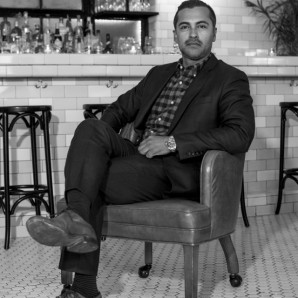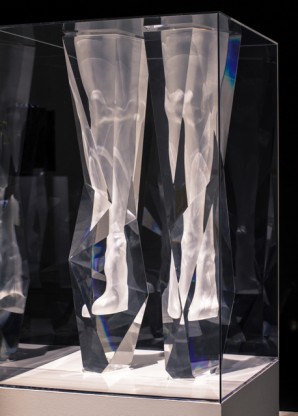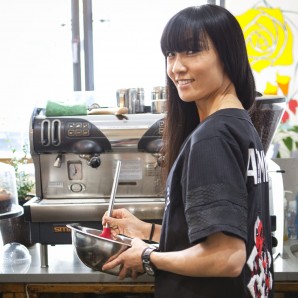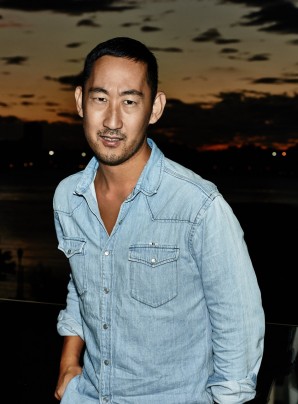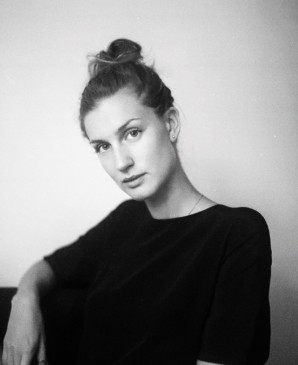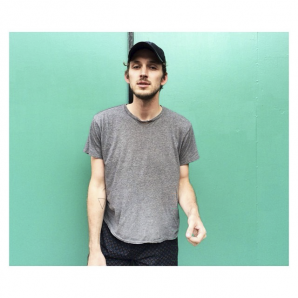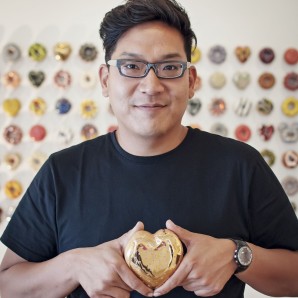"Cheng-Huai Chuang was introduced to fashion at a young age"
GARETH PUGH: ORGANIZED CHAOS
Gareth Pugh is a study in contrasts; balancing the demands of what is created and what is worn; what is in a designer’s control and what is in the hands of the wearer; what must be planned and what must be left to chaos. Recently Pugh’s work conveys a comfort level in what he does and how it exists in the larger context of fashion. No longer focused on pure shock value, Pugh recently spoke with TWELV about his creative process and the fashion industry, as well as the increasing sense of maturity exhibited in his creations. His good friend Tallulah Harlech, daughter of Chanel muse Lady Amanda Harlech and actress in Ralph Fiennes' new film "The Invisible Woman", showcases Pugh's newest designs in a lush garden in London.
What is your process in creating a collection? Do you need to contemplate an idea for a long time, do you create from instinct and a generative process, or is it a bit of both?
It’s actually a bit of both. I do tend to think about things a great deal, but there are moments- happy accidents lets say- that can trigger a whole new direction for an entire collection. It’s very dangerous, of course, to rely on these moments, so I always like to create a solid basis, a sort of abstract narrative that could be as basic as a sense, or a feeling, to work from. It is very rarely something tangible, and usually very difficult for me to communicate this narrative to anyone else, but things begin to solidify and crystallize as we work on the various elements of the show. It is very satisfying for me when all the elements come together and form a complete image.
Your work seems to be centered on a type of creative narrative, or a type of story that is communicating an abstracted idea. What role do you see that type of fashion playing in the wider scope of the fashion industry?
Everyone can relate to a story, no matter how abstract. Take away the story, and what you are left with is simply an aesthetic. An aesthetic is very easy to disengage from, while a narrative has the potential to become more ingrained, and feels like its part of something real, something physical, which ultimately is what makes fashion desirable. I would like to think that people want to be part of something that transcends the surface, and experience something that feels steeped in a certain ideology.
Where do you see fashion going in the future? Do you see artistic or conceptual approaches to fashion becoming more important?
It’s easy to feel a little despondent about fashion at the moment. I do think that there needs to be some sort of seismic shift – a total re-evaluation of what we value and look towards.
What are your views on the turnover of fashion? As an art-related designer do you wish that you had a seasonless time limit to develop ideas, or do you feel that the rigid pace of seasons keeps you motivated and focused?
Having such rigid deadlines is something that I am used to, and also think is very necessary. If I was afforded all the time in the world to work on something before letting it go, it would be impossible to actually do so. Nothing is ever perfect, and though this is a difficult lesson to learn, you very quickly realize that this sense of dissatisfaction is what spurs you on to do the next thing; a constant and never ending search for perfection. I like being able to build something up, then completely destroy it and start fresh. There is definitely something quite sadistic in this approach, yet being able to develop a visual language, and discover new ways of doing things along the way makes the process easier as time goes on.
How do you wish your customer to interact with the clothing that you create for her beyond the corporeal? What are you hoping that she feels when wearing your clothing?
Once you set something free, you lose control. What I wish for in this respect is immaterial.
What is the significance of gray, black, blue, and white in your work?
It’s simply about minimizing visual noise, and an attempt to offer an idea in its most basic form.
Many of your clothes are architectural and mathematical in structure. What is the relationship between the body and the angularity of your work?
It is more to do with a desire for control. Out of a sometimes very chaotic process comes this definite yearn for clarity. This is something that undoubtedly permeates the clothes.
You are able to deftly wrap the body in volumes of fabric without overwhelming the wearer. Can you explain the symbolism that you see behind that?
I don't like to overthink each and every aspect of what I do, that’s very important, it allows me a certain freedom to do something because it feels right, rather than constantly thinking about what it means to do it. I would argue that that’s not necessarily part of my role, as self-awareness at a certain level is an important asset, but taken too far can be very dangerous.
What designer’s work most often attracts your attention or has an influence on your own work? Do you feel it is more or less relevant to look at historical dress versus contemporary work?
That’s a difficult question to answer. I would describe my taste as that of a schizophrenic magpie.
Do you think the fashion press generally understands your work, or do you think that they miss the mark?
There are definitely certain people who get it, and who take the time to actually understand it rather than simply look, though that’s not really something that bothers me. If I'm pleasing everyone, I’m definitely doing something very wrong indeed.
You work with a lot of the same people each season in support of your fashion show presentations. Is it more collaborative in nature, or are most of the choices a part of your vision that they carry out?
I usually have very definite ideas about how I want things to be. I work with people that I like – that’s very important to me – people that I feel comfortable with and people who are able to execute these ideas.
Would you say that you have a muse? What does the term muse mean to you?
My idea of a muse is a little idealistic, and that of someone who totally and without question inhabits the fantasy. My notion of a muse goes far beyond a person who simply wears the clothes and/or has a particular attitude that fits a certain designer or collection. A muse for me is someone who sacrifices themselves, who throws themselves on the fire like a phoenix.
By: Noel Palomo-Lovinski
Photography: Jessie Craig
Hair: Isabella Boettcher @ Terri Manduca. Makeup: Natsumi Minarita @ Untitled Artists. London using MAC. Manicurist: Ami Streets @LMC Worldwide using The New Black.
*This story was featured in TWELV's Fall/Winter 2013 Issue
related posts
NEW TYPE #12: DROMe - MARIANNA ROSATI INTERVIEW
" I carry in my heart the values I've learned from my hometown - such as being true to myself and to my style"
IKEMEN #30: JORGE URENA
IKEMEN (ē´k´mɛn): Japanese Slang
"REALLY, REALLY, RIDICULOUSLY GOOD LOOKING PEOPLE"
NEW TYPE #11: LODOVICO ZORDANAZZO INTERVIEW
TWELV Magazine sat down with Lodovico Zordanazzo during his NYC visit to discuss his new collection and unique perspective on shoe design.
NEW TYPE #9: J.ELSTER - JENNIFER ELSTER Interview
TWELV Magazine recently visited filmmaker and designer, Jennifer Elster, at her studio, The Development.
NEW TYPE #8: MORGANE LE FAY - Liliana Casabal Interview
Noritaka Tatehana Exclusive Interview
The talented young Japanese designer, Noritaka Tatehana, who collaborated with Iris Van Herpen to design Lady Gaga’s shoes.
CHAOS CHAOS Interview
Formerly known as Smoosh, Asy and Chloe Saavedra of Chaos Chaos have always been a sister-sister duo.
THE KNOCKS Takes Tokyo
Recently, electro-pop duo, The Knocks, visited Japan to perform in the ARC+TWELV party at ARC, a newly opened venue in Tokyo.
CAVERNS Interview
TWELV had privilage of chatting with our friends from the band Caverns. The trio hail from NYC and are pretty much all over the music scene here!
Michael Phillips Moskowitz, eBay Chief Curator & Ed. Director, Interview
TWELV Magazine had the pleasure of connecting with Michael Phillips Moskowitz, the Global Chief Curator & Editorial Director at eBay.
NEW TYPE #7: EKAT - Katya INTERVIEW
"Introducing a new generation of designers"
Mai Mukaida Interview
Makeup Artist / CEO, Lalitpur.
Believes in the power of cosmetic
and lives with women in Nepal.
M KOUGER INTERVIEW: Farmhouse
With the fabulous Chloe 81, the oysterrific Chloe 81 Blue Room and the recently opened Farmhouse Restaurant, M Kouger has established an essential trifecta of entertainment in NYC’...
NEW TYPE #6: BERENIK- Veronica Brusa INTERVIEW
"Introducing a new generation of designers"
REI SHITO INTERVIEW
Street Fashion Photographer
and Style Blogger.
Loves in Street and the Beyond
Interview: The Refined Opulence of Hoorsenbuhs
The Hoorsenbuhs name has become synonymous with exclusivity, craftsmanship, and opulence. Once nothing more than the ambitious brainchild of creator Robert Keith, the brand has become a staple in...
NEW TYPE #5: HAZE Collection INTERVIEW
"Introducing a new generation of designers"
IKEMEN #29: JAY XERO
IKEMEN (ē´k´mɛn): Japanese Slang
"REALLY, REALLY, RIDICULOUSLY GOOD LOOKING PEOPLE"
Travis Bass Interview
New York’s Greenwich Village is now home to a new and amazing club created by the ultimate party planner/Pop Up Club designer, Travis Bass, called ZAZOU.
NEW TYPE #4: SAUNDER - Emily Saunders interview
"Introducing a new generation of designers"
NEW TYPE #3: GLORIA YU interview
"Introducing a new generation of designers"
IKEMEN #28: CJ Swanton & Mariko Derpa
IKEMEN (ē´k´mɛn): Japanese Slang
"REALLY, REALLY, RIDICULOUSLY GOOD LOOKING PEOPLE"
NEW TYPE #2: VINTI ANDREWS - Vinti Tan and Paul Andrews INTERVIEW
"Introducing a new generation of designers"
NEW TYPE #1: DEJAN DESPOTOVIC INTERVIEW
"Introducing a new generation of designers"
BEHIND THE SCENES #3: KATSUYA KAMO
TWELV's Behind the Scenes takes a step back and visits the masterminds behind the camera.
SUK CHAI INTERVIEW "SCHAI"
“My hands and eyes ooze desire to create when I touch something special. When I touch the “right” fabric, I usually close my eyes and visualize all the things I can create.”
IKEMEN #27: M KOUGER
IKEMEN (ē´k´mɛn): Japanese Slang
"REALLY, REALLY, RIDICULOUSLY GOOD LOOKING PEOPLE"
NORITAKA TATEHANA EXCLUSIVE INTERVIEW
NORITAKA TATEHANA EXCLUSIVE INTERVIEW
IKEMEN #26: KANAMI KAWAGUCHI
IKEMEN (ē´k´mɛn): Japanese Slang
"REALLY, REALLY, RIDICULOUSLY GOOD LOOKING PEOPLE"
MAISON KITSUNé INTERVIEW
During their first ever showing in New York Fashion Week, TWELV Magazine and I got to catch up with the talented duo behind the remarkable brand, MAISON KITSUNÉ, We spoke with Gildas Loaëc and...
MARIA HEDMARK INTERVIEW
Although Swedish transplant MARIA HEDMARK has only been in New York City for three years, her line, LINIE NYC, takes its name straight from the city that never sleeps.
IKEMEN #25: LANDON MILLER
IKEMEN (ē´k´mɛn): Japanese Slang
"REALLY, REALLY, RIDICULOUSLY GOOD LOOKING PEOPLE"

